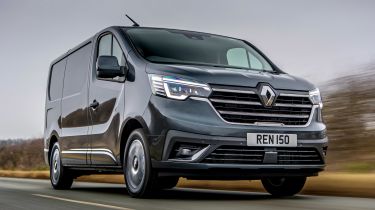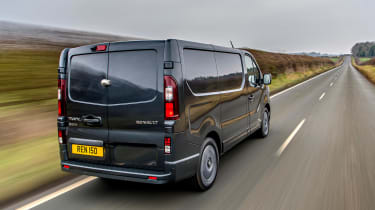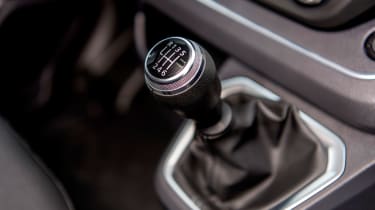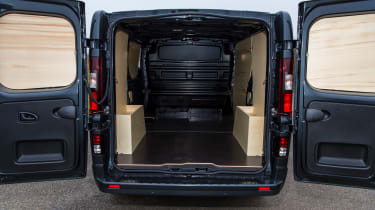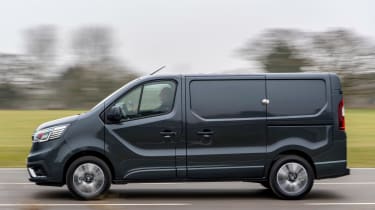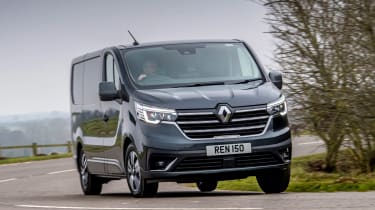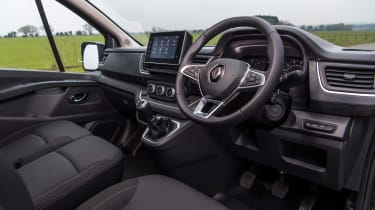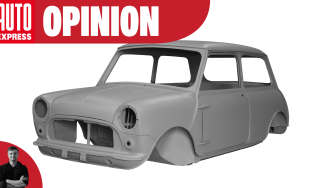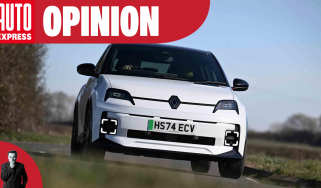Renault Trafic van review
The Renault Trafic remains a top mid-size panel van with economical engines, an electric version and some clever cabin touches
Our opinion on the Renault Trafic
This generation of Renault Trafic has been around for over a decade, but several major updates have kept it looking and feeling reasonably fresh. The latest was in 2022, ushering in an updated nose and new tech, most of which now comes as standard. In 2024 the electric Trafic E-Tech arrived in the UK, with just as much cargo space as the diesel panel van and a respectable payload, but a fairly short driving range and charging that tops out at a sluggish 50kW. It could still slash bills in urban use, but for jobs further afield, one of the diesels will be a better bet.
About the Renault Trafic
The current Renault Trafic has been around for a while now, but it's still a popular choice, ranking alongside the Renault Clio and Renault Captur as one of the firm's best-selling models. This generation of Trafic was first launched in 2014, but revisions and updates have kept it near the front of the medium-sized van pack. There have been updates inside and out along the way, and in 2024 an all-electric Trafic E-Tech arrived for the first time.
Up front, the Trafic has a stocky front end, with a squarer look than before, while C-shaped daytime running lights come as standard on all models. There's chrome trim for higher-spec models and alloy wheels, too. Inside, the cab now features switchgear carried over from the Renault car range, including climate controls, a touchscreen infotainment system, and a partially digital instrument cluster similar to that found in the Clio.
Used - available now

2022 Vauxhall
Mokka
32,005 milesManualPetrol1.2L
Cash £13,264
2024 Mercedes
EQB
39,188 milesAutomaticElectric
Cash £24,836
2023 FORD
TRANSIT CUSTOM
42,694 milesManualDiesel2.0L
Cash £18,390
2023 FORD
TRANSIT CUSTOM
43,720 milesManualDiesel2.0L
Cash £18,249One area that remains unchanged is the Trafic's cargo bay. The dimensions here are the same as before, so it's still one of the best-shaped cargo areas on offer in the medium-sized van class, and there's up to 8.6 cubic metres of space, depending on which size van you go for.
Trim levels are called Advance, Extra and Extra Sport. All models benefit from an eight-inch touchscreen with Apple CarPlay and Android Auto connectivity, DAB radio with Bluetooth, ESC stability control, a full steel bulkhead, remote central locking, a sliding side door and electronic stability control and speed limiter.
Extra trim adds navigation with three years of connected services thrown in free, automatic headlights, upgraded interior trim with LED lighting, 17-inch alloy wheels, body-coloured exterior trim and a rear-view camera. Extra Sport brings climate control, 17-inch alloy wheels, all-around parking sensors and keyless entry.
Three diesel engines are offered, all based on the same 2.0-litre Blue dCi diesel that was introduced in 2019. The dCi 110 version is no longer offered, so buyers can pick between the dCi 130 and more powerful dCi 150, while a dCi 170 version is also offered in the Extra Sport trim. All of these come with stop-start, with the dCi 130 having the six-speed manual gearbox only, while the dCi 150 and dCi 170 have a six-speed EDC auto option available. The dCi 170 is only offered in higher Sport and Sport+ trims.
Electric van customers are also served by the Renault Trafic E-Tech, which first arrived on British roads in 2024. This gets a 120bhp electric motor and a 52kWh battery for a range of around 186 miles. Cargo volume is unaffected, but it does have reduced payload and towing figures versus the diesel Trafic
The Renault Trafic's chief rival is the Ford Transit Custom, the UK's best-selling van. But there's more to the medium-sized van class than just the Transit Custom, since the Volkswagen Transporter and Mercedes Vito are also strong challengers. Elsewhere, the Vauxhall Vivaro, Citroen Dispatch, Peugeot Expert and Toyota Proace are badge-engineered versions of the same vans, but are more car-like than the other models mentioned here. Closer to home, the Renault Trafic is also sold as the Nissan Primastar (the Nissan having now swapped back to that name from NV300 previously used).
MPG and running costs
| Pros |
|
| Cons |
|
Changes to the Renault Trafic engine line-up haven't come at the expense of fuel efficiency. In fact, the most recent engines are more economical than the ones they replaced. The dCi 130 and dCi 150 both have official WLTP figures of up to 40.9mpg, while the dCi 170 is only slightly behind at 39.8mpg. Adding an automatic gearbox to the 150 engine has no effect on its official economy rating.
Stop-start is standard to help improve fuel economy, while Renault's 'ECO' mode button is carried over. However, this tends to blunt the van's performance, so any energy saving it might offer is likely to be offset by the extra time that's needed to get the van up to speed in the first place.
All Trafic vans come with an 80-litre fuel tank, so theoretically you should be able to do more than 600 miles between fills. AdBlue is used to clean up the van's emissions, and it’s stored in a 25-litre tank that needs to be filled every few thousand miles. The van's trip computer will notify you when it's time to do so.
Pick the Trafic E-Tech and it gets a 52kWh battery for an official range of 186 miles. This is 12kWh smaller than the battery in the Ford E-Transit Custom, which results in a longer 209-mile WLTP range. To compensate for this, the Renault features a long-range mode that helps extend its range to approximately 200 miles. However, this mode also reduces performance and limits the top speed to 56mph.
Charging from 15 to 80% takes around 12 hours using a 3.7kW wallbox, 5.5 hours at 7.4kW and just under an hour using a 50kW public DC charger.
Other highlights of Renault Trafic ownership include a three-year/100,000-mile warranty (as well as three years of breakdown cover), with service intervals every two years or 24,000 miles, whichever comes first. Renault's PRO+ network of commercial vehicle dealers is also available to help keep downtime with your van as short as possible.
Load space and practicality
| Pros | Cons |
|
|
The Renault Trafic is one of the most spacious mid-sized vans on the market, and this has been unchanged over the course of its updates, which focused largely on efficiency, cabin quality and a new front-end design.
An overall length of 5,080mm for the standard L1 Trafic (and 5,480mm for the L2 model) means it's one of the longer vans on the market, and the standard panel van has 5.8 cubic metres of cargo volume in the back. Crucially, this enables the smallest Trafic to carry three Europallets or 11 standard sheets of plasterboard.
Moreover, Renault includes a special 'load through bulkhead' as standard. This is basically two flaps, one at floor level in the bulkhead behind the passenger seat and a second under the passenger seat itself. Open the first, and planks or piping of up to 2.95m in length can be accommodated. Open the second and you've got 3.75m to play with. Again, that's in the short-wheelbase model. In the long wheelbase Trafic with the load through the bulkhead, the maximum load length is a class-leading 4.15m. To help tie down loose items, there are 16 anchorage points found around the standard Trafic's cargo area, while the long-wheelbase van has 18 anchors.
Renault also fits a clever catch for the asymmetrically split rear doors. This allows the left hand door that carries the Trafic's rear number plate to be locked in place, so very long items can be poked out of the right hand door and carried with rear lights and number plate still visible. An internal ceiling rack is also available as an option, along with Renault's range of fully warrantied internal racking and storage solutions.
As well as the panel vans in two wheelbases and two roof heights, Renault offers a six-seater crew van, a nine-seater minibus and a platform cab ready to take a host of conversions.
It’s also worth noting that the dCi 130 and 150 versions can tow a 2,500kg braked trailer, but this drops to 1,630kg for the 170 Auto and to just 920kg for the Trafic E-Tech.
Reliability, safety and security
| Pros |
|
| Cons |
|
The Renault Trafic has a solid safety specification as standard, but you need to upgrade to a higher spec if you want the safest van possible. All vans get a full steel bulkhead between the cab and cargo area, a driver's airbag, ABS with EBD and ESC stability control with hill start assist and Grip Xtend to help out on slippery surfaces. Driver, front and curtain airbags with passenger deactivation are standard.
There’s also a 'Wide View Mirror', which is a giant vanity mirror on the passenger sun visor. All Renault Trafics come with single mirrors that are curved to create a wide-angle view towards the edge of the glass, but the visor mirror helps to eliminate the Trafic's nearside blind spot by increasing the driver's field of vision. The only problem is that any passenger is left staring at their reflection for the duration of the trip. On the security front, all models get deadlocks, an immobiliser and an alarm, while Renault offers a number of deadlocks and security add-ons as part of the Trafic's range of accessories.
Lane departure warning is now standard with Advance trim, which is an audible and visual warning that you're straying from your lane, accompanied by a light-up warning in the dashboard and a bassy rumble through the speakers, similar to the sound you'd hear if crossing a white line at the edge of the motorway. It's not too intrusive, and it can be turned off if necessary.
Upgrade to Extra Sport trim and you’ll get front, rear and lateral ultrasonic sensors to help avoid dings and make parking easier.
Driving and performance
| Pros |
|
| Cons |
|
Renault replaced the Trafic's earlier 1.6 twin-turbo diesel engine with a larger 2.0-litre single turbo unit in 2019, and not only did this help improve the van's economy in the WLTP tests, but it also means the Trafic is more responsive in everyday driving. The most powerful dCi 170 produces 380Nm of torque at low revs, allowing it to pull smoothly from 1,500rpm. Even the lowest-powered dCi 110 packed a surprising amount of punch, courtesy of its 300Nm torque figure, but this version is no longer offered. The entry-level dCi 130 gets an even healthier 330Nm of pulling power.
On the road, the Trafic is largely the same as before, with a commanding view of the road, a comfortable driving position and good rearward visibility. The 2.0 dCi makes life easy because it's so quiet, while the six-speed gearbox has a decent shift action.
Town driving, visibility and parking
That high driving position helps in town, while wide-angle mirrors - including the additional wide-view mirror in the passenger-side sun visor - help you to manoeuvre. A rear camera, front and rear parking sensors, lane departure and city braking are all available, too.
Renault's EDC six-speed auto really takes the strain out of driving in town. We haven't tried it in the revised model, but past experience reveals that it shifts smoothly, although it's a bit slow to react when you accelerate. It also seems keen to kick down whenever you use the throttle, which can send the revs soaring. There's a manual mode (but no paddle shifters), which is effective at holding gears when you're negotiating a steep downhill slope.
Renault has plenty of expertise in the electric passenger car market, and we suspect the smooth power delivery of an electric motor will make the Trafic E-Tech the best version to drive around town.
Motorway driving and long-distance comfort
The suspension is tuned towards load carrying over comfort, but it doesn't feel too bouncy when unladen, and the Trafic is pretty smooth on longer runs.
Cab interior and technology
| Pros |
|
| Cons |
|
Renault has gradually updated the Trafic during its time on sale, and it’s now more like a passenger car than ever. The dashboard has been revised with an uncluttered layout and some brushed silver trim on the Extra and Extra Sport trims, while the climate controls and eight-inch infotainment touchscreen will look familiar to anybody who has driven a Clio or Captur in the past few years.
The multifunction steering wheel is a carry-over, too, as is the stubby audio control system set down to the right of the steering column. We also found the smartphone display didn't fit proportionally within the eight-inch screen, and was squeezed vertically a little.
As before, there's up to 90 litres of storage space inside the cab, depending on which of the 14 possible storage spaces are present. The highlight from a user-friendliness point of view is Renault's Mobile Office, which is now standard. It's a middle front passenger seat with a fold-down back that reveals a table with a detachable clipboard and a laptop storage space. It doesn't seem to be quite on a par with the rest of the cabin in terms of robustness, but it will definitely be a useful addition for those with paperwork to do on the move.
Infotainment, sat-nav and stereo
The Trafic range now features Renault's Easy Link eight-inch infotainment system from the off. This allows you to hook up a smartphone and use either Android Auto or Apple CarPlay, while Extra and Extra Sport models include connected sat nav with live updates. Every version also gets a 4.2-inch TFT colour trip computer display between the dials in the instrument cluster.
Whichever model you choose, Bluetooth is standard on all vans, so connectivity shouldn't be an issue. USB and 12-volt charging sockets also feature, and you can add 12-volt charging to the cargo area, too.
Buying and owning
The best Renault Trafic for your needs really boils down to how it will be used. If it’s mostly for short urban trips or city driving, the Trafic E-Tech will cost the least to run and has plenty of cargo space. For motorway or rural driving, the Blue dCi 130 diesel should be fine, and the extra performance and expense of the more powerful engines is probably unnecessary.
It’s a similar story with trim levels; unlike with the older trims, the entry-level Advance model now gets pretty much all the kit you need, from an eight-inch touchscreen with smartphone connectivity to a table you can use to work while parked up.
Alternatives
Medium panel vans are the most popular in the UK, so the Trafic isn’t short of rivals. The Ford Transit Custom and Volkswagen Transporter are very similar under the skin and have only recently launched, so they arguably give the Renault its stiffest competition.
They don’t differ too greatly in cargo volume, but beat the Trafic in some key areas like payload. If you want an electric van, they also offer a longer driving range than the Trafic E-Tech. Other rivals include the Vauxhall Vivaro, Citroen Dispatch, Peugeot Expert and Toyota Proace, all of which are very similar vehicles and share a lot of parts.
Van dimensions
| |||
| Body style | Height | Width | Length |
| L1 van | 1,971mm | 1,956mm | 5,080mm |
| L2 van | 1,967mm | 1,956mm | 5,480mm |
Load area dimensions | ||||
| Body style | Height | Width | Length | Volume |
| L1 van | 1,387mm | 1,662mm | 2,537mm | 5.8m3 |
| L2 van | 1,387mm | 1,662mm | 2,937mm | 7.8m3 |
Frequently Asked Questions
There’s not really much wrong with the Trafic, but it is starting to feel a bit dated next to newer rivals and the electric Trafic E-Tech has a fairly short range. It’s worth noting that a new Renault Trafic is on its way.
